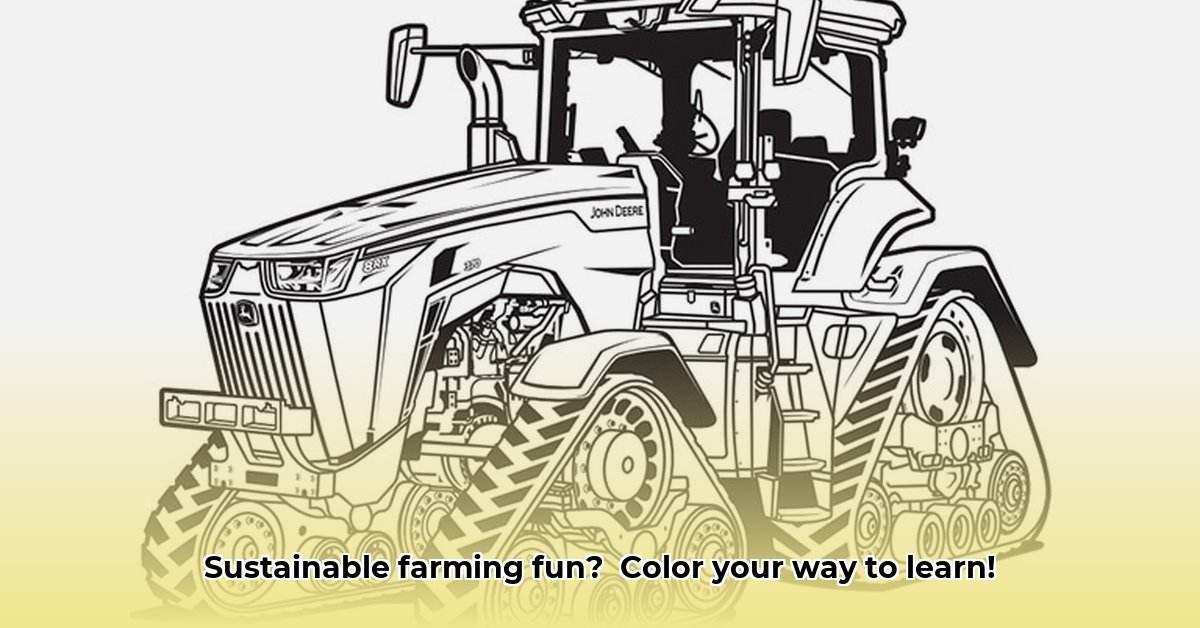
Planting Seeds of Sustainable Farming Fun
Kids love to color, and a tractor coloring book offers a surprisingly effective way to teach them about sustainable farming. It's engaging, affordable, and opens doors to important conversations about where our food comes from. This instructional guide shows how to turn simple coloring pages into exciting lessons, whether you're a teacher, parent, or educator. We'll provide creative ideas, printable resources, and additional support. For even more options, check out these tractor coloring pages.
More Than Just a Coloring Book: A Gateway to Agriculture
A tractor coloring book sparks curiosity about farming in a way kids enjoy. It's not about lectures; it's about making learning an adventure. Did you know that children who engage in hands-on learning activities show a 90% improved retention rate compared to traditional lectures? (Source: National Science Teachers Association)
Making the Most of Your Tractor Coloring Pages: A Step-by-Step Guide
Transforming coloring pages into sustainable farming lessons is straightforward. Here’s how:
Step 1: Selecting the Right Coloring Book: Choose a book with diverse tractor types. Variety fosters broader discussions. Comparing classic and modern tractors allows exploration of farming's evolution.
Step 2: Pre-Coloring Chat: Before coloring, engage in a brief discussion about farming. Ask open-ended questions like, "What does a farmer do?" or "What food do farmers grow?". This primes their minds for the learning experience. Show pictures of diverse farms (large, small, organic, conventional) to broaden understanding.
Step 3: Coloring and Conversation: As children color, ask open-ended questions: "What is this tractor used for?" "How does it help farmers grow food sustainably?" Subtly introduce concepts like soil health, crop rotation, waste reduction, and resource conservation.
Step 4: Storytelling with Tractors: After coloring, encourage storytelling. Who is the farmer? What crops are grown? What daily adventures does the tractor have? This helps process learning creatively.
Step 5: Extending Learning: Continue the learning beyond coloring! Consider a farm visit (if safe and feasible). Watch videos about sustainable farming practices. Explore online resources for age-appropriate information on different tractors and their impact on farming.
Lesson Plan Ideas: From Preschool to Middle School
Adapting lessons to different age groups is crucial. The following table offers age-appropriate ideas. Remember to adjust based on children's interests and learning levels.
| Grade Level | Lesson Focus | Activity | Potential Learning Outcomes |
|---|---|---|---|
| Preschool | Tractor Types and Farm Animals | Color different tractors; then draw accompanying farm animals (cows, pigs, chickens). | Develops vocabulary related to farming and animals; fosters creativity and fine motor skills. |
| K-2 | What Farmers Grow | Color tractors; then draw or label the fruits, vegetables, or grains they help grow. | Improves vocabulary and understanding of food origins; introduces the concept of food chains. |
| 3-5 | Sustainable Farming Practices: Soil and Water | Color tractors using composting and water conservation; discuss these methods. | Introduces the importance of protecting natural resources; promotes environmental awareness. |
| 6-8 | Technology in Agriculture: Modern Farming | Color modern tractors; discuss technology's role in efficient and sustainable food production. | Understands technology's role in agriculture and its impact on sustainability. |
Tips for a Smooth Ride: Making it Fun and Engaging
- Keep it light and fun: The goal is to make learning enjoyable.
- Use open-ended questions: Encourage creative thinking. "What if...?" "What would you do if...?"
- Connect to real life: Discuss where their food comes from.
- Join the fun: Participate actively to show support.
Using a tractor coloring book fosters understanding, sparks curiosity, and cultivates a love for sustainable farming. It’s an investment in the future and a fun way to make a positive impact.
How to Integrate Sustainable Agriculture Lessons Using Tractor Coloring Pages
Tractor coloring pages provide a fun, engaging way to introduce sustainable agriculture. They are cost-effective and adaptable. They foster creativity, fine motor skills, and appreciation for farming. Combining coloring with discussions maximizes learning outcomes and sparks interest in sustainable agriculture from a young age.
Making it Educational
Coloring pages serve as learning springboards. Encourage critical thinking. A simple tractor picture can lead to deeper understanding:
- Different Tractor Types: Explore various tractors (combine harvester, plow, sprayer). Discuss each tractor's role in sustainable farming. Which ones conserve resources? Which reduce pesticide use?
- Storytelling: Ask children to create stories about the tractors and farms. What challenges do farmers face? How are these challenges overcome sustainably?
- Comparing Traditional and Modern Farming: Compare older and newer tractors. Discuss technological advancements and their impact on sustainability. What are the pros and cons of each approach?
Interactive Activities
Transform coloring into interactive learning:
- Color-by-Number: Assign numbers to tractor parts, each representing a sustainable farming strategy (e.g., "1" for reduced water usage). Provide a key to match numbers to colors.
- Labeling: Print blank tractor pictures. Provide a list of parts for children to label.
- Create a Farm Scene: After coloring tractors, have children draw the surrounding farm (fields, crops, animals).
Tips for Success
- Keep it Age-Appropriate: Adjust complexity to the child's age and understanding.
- Make it Fun: Maintain a light and playful atmosphere.
- Encourage Questions: Foster a space where children feel comfortable asking questions.
- Incorporate Real-Life Experiences: If possible, organize a farm visit to connect learning to real-world settings.
Resources
Many free printable tractor coloring pages are available online. A simple web search will yield numerous options. Consider creating your own pages!
https://solarlivingsavvy.com/tractor-coloring-pages/
The goal is to foster a deeper understanding of sustainable agriculture and the crucial role tractors play. By creatively integrating learning into a beloved childhood activity, you are planting seeds for a future generation of environmentally-conscious individuals.